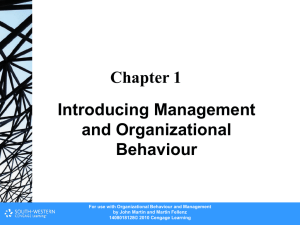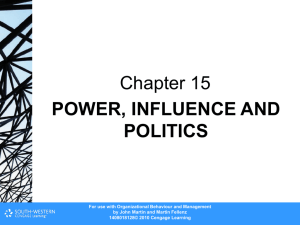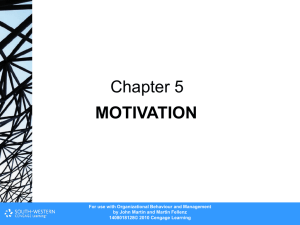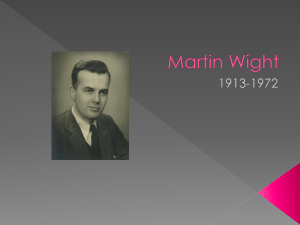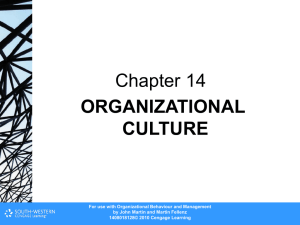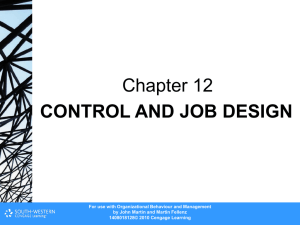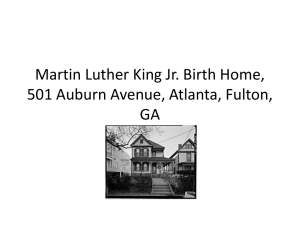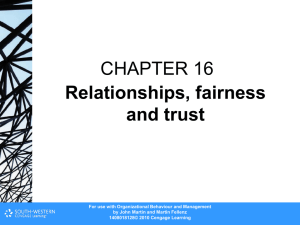Chapter 3 - Cengage Learning
advertisement
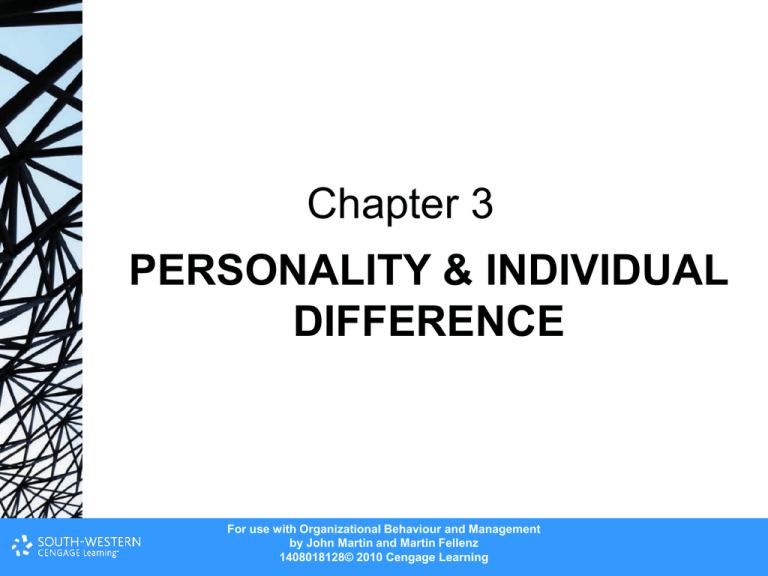
Chapter 3 PERSONALITY & INDIVIDUAL DIFFERENCE For use with Organizational Behaviour and Management by John Martin and Martin Fellenz 1408018128© 2010 Cengage Learning Strong and weak situations • Table 3.1 For use with Organizational Behaviour and Management by John Martin and Martin Fellenz 1408018128© 2010 Cengage Learning The study of individual difference • Genetic influences • Environmental influences - Family - Society, community and culture - Experience For use with Organizational Behaviour and Management by John Martin and Martin Fellenz 1408018128© 2010 Cengage Learning Relationship between the determinants of personality • Figure 3.1 For use with Organizational Behaviour and Management by John Martin and Martin Fellenz 1408018128© 2010 Cengage Learning Nomothetic perspectives Eysenck and the study of personality types: • Extroversion • Neuroticism Cattell and personality characteristics - 16 factors Including: • Warmth • Liveliness • Sensitivity • self-reliance The ‘Big Five model: • Extraversion • Emotional Stability • Agreeableness • Conscientiousness • Openness to experience For use with Organizational Behaviour and Management by John Martin and Martin Fellenz 1408018128© 2010 Cengage Learning Eysenck and personality types • Figure 3.2 For use with Organizational Behaviour and Management by John Martin and Martin Fellenz 1408018128© 2010 Cengage Learning Cattell and personality characteristics • Figure 3.3 For use with Organizational Behaviour and Management by John Martin and Martin Fellenz 1408018128© 2010 Cengage Learning Cattell and personality characteristics • Figure 3.4 For use with Organizational Behaviour and Management by John Martin and Martin Fellenz 1408018128© 2010 Cengage Learning Idiographic perspectives Cooley: •The looking-glass self - We begin to see (understand) ourselves as others see us through the responses that we generate from others Mead: • I - The unique, spontaneous and conscious aspects of the individual • Me - The internalized norms and values learned through experience within society For use with Organizational Behaviour and Management by John Martin and Martin Fellenz 1408018128© 2010 Cengage Learning Rogers’ View of the ‘I’ and ‘me’ • Figure 3.5 For use with Organizational Behaviour and Management by John Martin and Martin Fellenz 1408018128© 2010 Cengage Learning Freud and psychoanalysis There are three levels of mental activity: The mind consists of three areas: • Unconscious • Pre-conscious • Conscious The main forms of ego defence mechanism: • Sublimation • Repression • Denial • Projection • Reaction formation • Regression • Isolation • Undoing For use with Organizational Behaviour and Management by John Martin and Martin Fellenz 1408018128© 2010 Cengage Learning • Id • Ego • Superego Jung and the cognitive approach Three levels of personality: • A conscious level • An unconscious level • A collective unconscious Four different approaches to information gathering: • Sensing • Intuiting • Thinking • Feeling For use with Organizational Behaviour and Management by John Martin and Martin Fellenz 1408018128© 2010 Cengage Learning Jung’s cognitive styles • Figure 3.6 For use with Organizational Behaviour and Management by John Martin and Martin Fellenz 1408018128© 2010 Cengage Learning Differences between Jung’s cognitive styles • Table 3.2 For use with Organizational Behaviour and Management by John Martin and Martin Fellenz 1408018128© 2010 Cengage Learning Personality dimensions particularly relevant in organizations • Table 3.3 For use with Organizational Behaviour and Management by John Martin and Martin Fellenz 1408018128© 2010 Cengage Learning Other personality traits relevant in organizations • • • • • • • Locus of Control - Rotter, (1966) Need for Cognition - Cacioppo & Petty (1982) Self-monitoring - Snyder (1974) Proactive Personality Need for Achievement ) Need for Power ) McClelland Need for Affiliation ) For use with Organizational Behaviour and Management by John Martin and Martin Fellenz 1408018128© 2010 Cengage Learning Developing psychometric tests Step 1. Initial ideas often emerge from practical need Step 2. The development of appropriate test items is a creative process Step 3. The final forms of the test are developed and the administration arrangements designed Step 4. The standardization and ‘norming’ process Step 5. Reliability and validity analyzes applied to data For use with Organizational Behaviour and Management by John Martin and Martin Fellenz 1408018128© 2010 Cengage Learning Psychometrics Three ways in which tests can measure individual difference: • Performance versus standard • Norm-referenced measurement • Criterion-referenced measurement There are different forms of validity and reliability: • Face validity • Predictive • Construct validity • Test/retest reliability • Alternative form reliability • Split half reliability For use with Organizational Behaviour and Management by John Martin and Martin Fellenz 1408018128© 2010 Cengage Learning ABILITY: INTELLIGENCE AND EMOTIONAL INTELLIGENCE • Physical abilities - people’s capacity to control and deploy their bodies and to manipulate their physical environment • Cognitive abilities - a broad range of mental capabilities. The most often general terms for these abilities is intelligence • Intelligence - the general mental ability to solve problems and successfully deal with environmental conditions and demands in varying situations • Emotional intelligence - the ability to carry out accurate reasoning about emotions and the ability to use emotions and emotional knowledge to enhance thought For use with Organizational Behaviour and Management by John Martin and Martin Fellenz 1408018128© 2010 Cengage Learning Emotional intelligence Dulewicz and Higgs model: •The drivers - The two traits of motivation and decisiveness are responsible for energizing individuals to achieve their goals •The constrainers - The two traits of conscientiousness and integrity, and emotional resilience perform the function of modifying the potential of the drivers to push to excess or in the wrong direction •The enablers - The three traits of sensitivity, influence and selfawareness help to ensure that the other traits operate in the social context involving the individual and other people For use with Organizational Behaviour and Management by John Martin and Martin Fellenz 1408018128© 2010 Cengage Learning Organizational applications of individual difference Recruitment and selection Development • Occupational Personality Questionnaire (OPQ) • Assessment Centres Discrimination Stress and bullying The testing business For use with Organizational Behaviour and Management by John Martin and Martin Fellenz 1408018128© 2010 Cengage Learning

